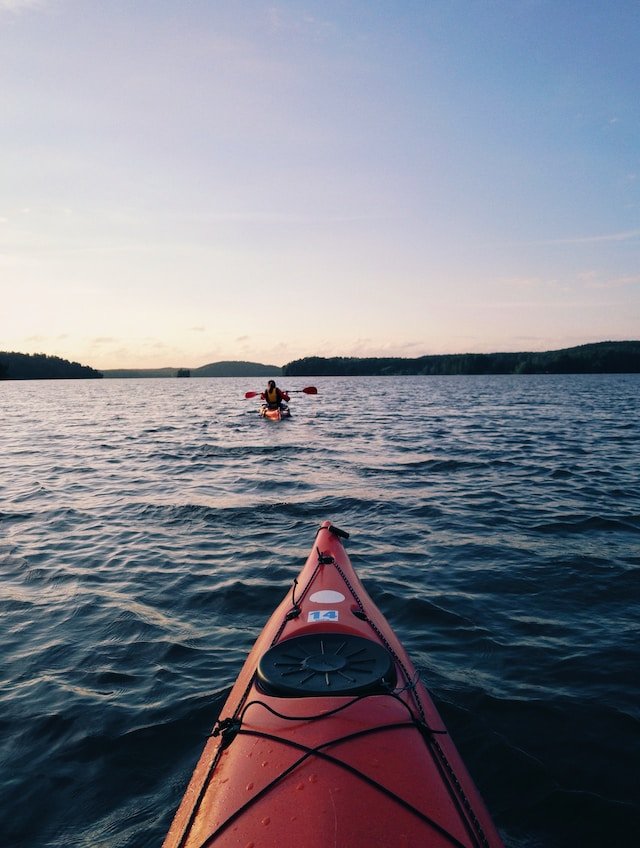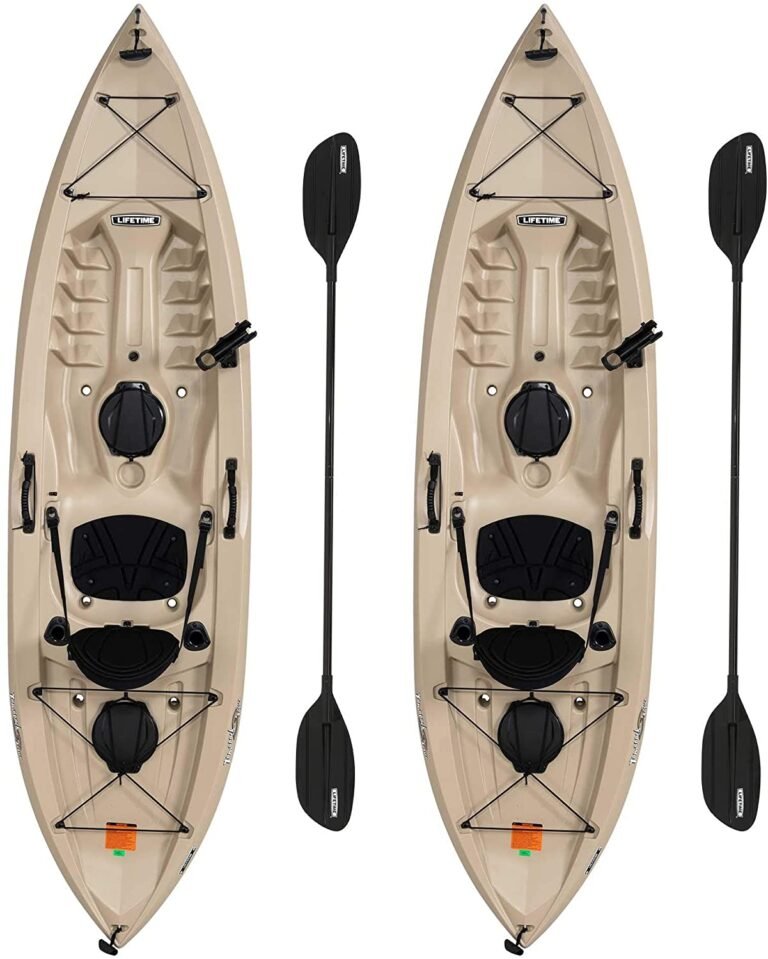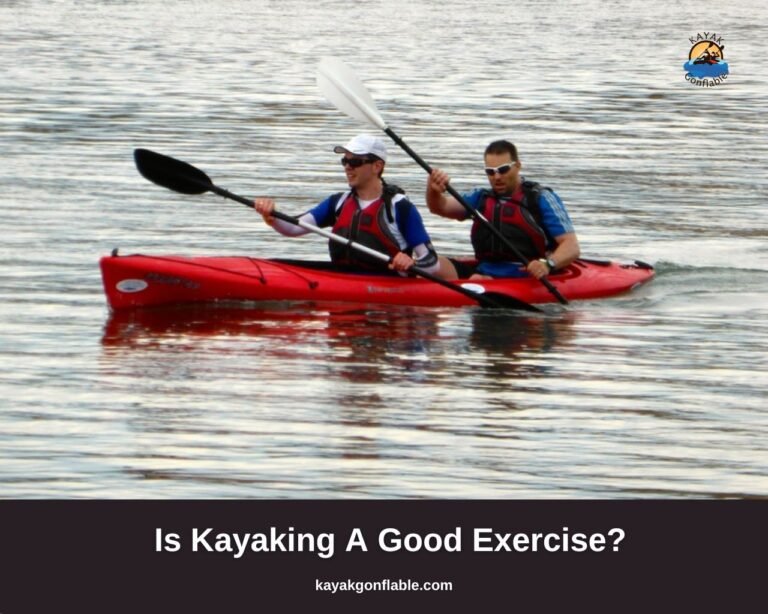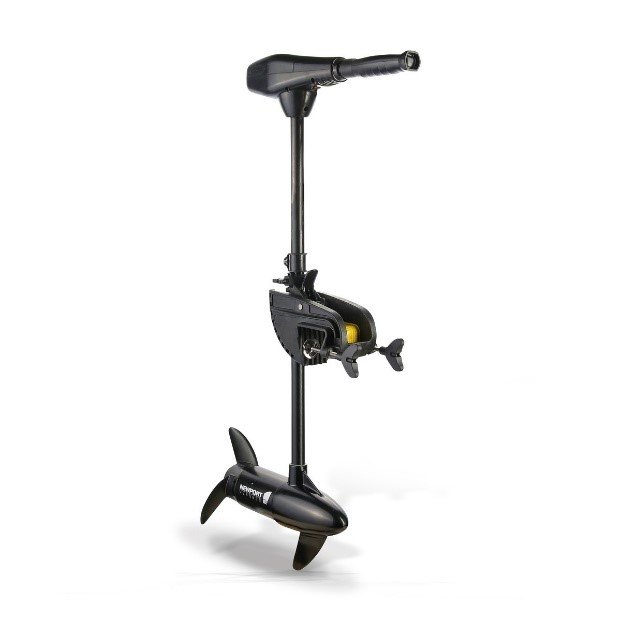How Far Can You Kayak In A Day?

Kayaking is a popular watersport whose influence grows daily. The sport involves propelling a watercraft called a kayak through water with the use of a paddle. As most beginners quickly find out, it is almost impossible to not fall in love with this wonderful sport.
A natural question that rises to the mind then is how far can you go should you decide to kayak for a whole day. There are many reasons why you may want to know this; it could help you plan your journey and ensure you follow your schedule.
It also gives you an estimate of how far from your starting point you would be at any point in time. Most beginners spend about two to three hours kayaking at a time while learning the sport.
This is because they are yet to master all the required skills to successfully handle themselves on the water. As they master the sport, however, the time spent kayaking naturally increases to the point they are ready to spend whole days kayaking.
How far then can one kayak in a day? As you may have already guessed, the answer to this question depends on several factors.
Most kayakers average about two miles an hour when kayaking all day but this number can increase given the right circumstances. We look into how far you can kayak daily and the factors affecting this distance.
Factors Affecting How Far You Can Kayak In A Day
Once hooked on the sport of kayaking, you just want to kayak till you are tired then kayak some more. Covering much ground while enjoying the beautiful scenery is something all kayakers love.
Knowing what affects how much ground you can cover in a day is thus crucial. The factors affecting how far you can kayak in a day are explained below.
1. The Speed Of The Kayak
Kayaking is a great way to get in shape and spend some time outdoors. The distance you can kayak in a day is largely determined by the speed of the kayak.
A slow kayak will allow you to view more scenery in detail than a fast kayak, but it will also take you longer to cover much ground in similar conditions.
The speed of the kayak depends on a lot of factors ranging from your paddling speed to weather conditions, and the kayak design.
If you want to cover much ground, you will want a kayak known for speed as the faster the kayak sails the more ground you can cover per unit time.
2. Daylight
As ironic as this might seem, you can only be on the water for as long as you can see and nightfall is usually the sign to put an end to the day’s adventures.
The more daylight a day has, the more ground you will be able to cover before it gets too dark to navigate the waterway safely.
Unless you are equipped to kayak at night and planned for that eventuality, daylight significantly determines how far you can kayak in a day.
3. Your endurance
Another factor to consider is how long you are willing to sit in your kayak paddling. Even in the best kayaking conditions, you can only kayak as far as your body can before taking breaks or giving up – paddling is an exhausting exercise especially if you are not used to it.
If you have been kayaking for a while or are involved in other endurance-building sports, you can probably maintain a speed in your capacity range for quite some time before needing to rest.
If you are just starting, however, you will likely get tired easily and have to take regular breaks. This will significantly reduce how far you can travel.
4. The weather conditions
Anyone who has spent time on the water will tell you the weather decides whether it wants you out there or not and disobeying the weather’s wishes often comes with dangerous and sometimes deadly consequences.
A safe kayaking practice is to always check the weather forecast before hitting the water. This is to know if you will have favorable conditions or if you should postpone your trip.
In favorable weather, it is easy to cover a lot of ground as the weather itself puts you in a joyful mood. Bad weather makes for a difficult adventure and easily wears away your enthusiasm. The result is that you end up not paddling very far before seeking refuge from the hostile elements.
Kayakers should know how to navigate waterways in all weather conditions as the weather can change abruptly without warning and weather reports are not always reliable. Kayaking is nevertheless severely discouraged in hostile weather except if it is necessary.
Depending on the time of the year and location of the expedition, kayakers may have to experience some unfavorable weather conditions on their kayaking adventure particularly if they are on a long trip.
5. The Currents Or Waves
Waves are a common sight on the water. The temperament of the waterbody you are navigating will play a major role in how much ground you will cover.
Say the currents are in your favor, they will speed up your trip and reduce the energy required for paddling. The result is an enjoyable trip and you travel quite fast.
The waves may however be against you to the extent that it might be better to cancel the expedition. In such conditions, it goes without saying that you won’t be able to paddle quite far.
While navigating rivers or lakes, the wind might create waves that could capsize your vessel or worse. Waves are ever-present on the ocean and you have to get accustomed to them if you want to keep kayaking at sea.
If the waves are too hostile, however, it is best to stop kayaking for a while till their tantrum is over. You can only keep enjoying kayaking if you are not injured or worse.
6. The Wind
You cannot talk about navigating water in a watercraft and ignore the wind; they are mutually inclusive. The wind plays a great role in whether it is safe for you to kayak and determines how fast you go and even in what direction you move.
Kayaks are typically light and while this is usually an advantage in normal conditions, high winds turn the table on kayakers as kayaks are sometimes blown off course.
Winds are also capable of creating troublesome waves that will make the kayaking trip particularly dangerous. Choppy waters are not safe for kayakers especially those with little experience.
Fortunately, on the flip side, the wind can be your friend and even an ally on your trip. Wind blowing in the direction you are paddling will help you go faster while conserving your strength.
Favorable wind will also keep you in a good mood and let you appreciate nature as you enjoy your trip.
7. The Kayak’s Weight
Another factor affecting how much ground your kayak will cover in the limited daylight hours is its weight. A heavier kayak makes for a more stable kayak.
It also makes for a slower kayak. Knowing how to balance the weight in the kayak for optimum speed and safety is something every kayaker should know how to do.
A heavy kayak displaces more water than its lighter counterpart and will consequently fare better in rough waters.
This implies that since a heavy kayak is less likely to be turned off course in adverse conditions, it will be able to cover more ground in adverse conditions. A lighter kayak will however cover more ground in fairer weather.
8. The Temperature
Temperature extremes make for a frustrating kayaking trip if you can endure being on the water at all. When the weather is too hot, kayakers run the risk of dehydration and have to constantly keep taking fluids.
The hot weather also makes one easily irritable and makes it easier to tire of paddling; you consequently don’t go very far on your adventure.
Cold weather has a similar effect in that it freezes your body to the point you are unable to paddle as you normally would decreasing your speed. You also run the risk of being down with hypothermia in cold weather.
If you must kayak at all in weather extremes, make sure you are aware of the risks and take all necessary precautions to keep yourself safe.
If you notice the signs of either dehydration or hypothermia, it’s best to get off the water immediately and seek treatment. It is better safe than sorry.
Generally, the temperature range between the extremes is safe for kayaking and you should be able to cover a lot of ground on your adventure.
9. Flow Rate (CFS)
Another factor affecting how far a person can kayak in a day is the river’s flow rate measured in cubic feet per second (CFS).
This factor is however specific to whitewater kayaking as oceans, lakes, and coastal waterways have no such thing. While kayaking on a river with a high flow rate, kayakers are more likely to cover a lot of ground.
It is crucial to note though that the faster the river flows, the more dangerous it is and you should be confident in your skills before deciding to take such risks.
It is also important to have the necessary equipment as kayaking in dangerous conditions requires precision and only the best available equipment can give you that thrill of exhilaration and danger while ensuring your safety.
10. Emergency Situations
It is common knowledge that things do not always go as planned and emergencies spoil even the best maid plans. A kayaker averaging two miles per hour with good endurance would expect to have covered 16 miles in 8 hours.
However, when things go south, he might have to cancel the trip altogether. When unfavorable or complicated situations arise and compromise your trip, you may have to choose between proceeding or going back to safety.
Dearest kayaker safety should always be your priority as the only way you can keep enjoying the joys of the wonderful sport of kayaking is if you are alive and well.
Avoid taking unnecessary risks and employ safe kayaking practices. When emergencies arise, employ the best course of action to ensure the safety of all those involved.
How far can you kayak in a day: Tandem Kayaks
A tandem kayak, also known as a double kayak, is a two-person kayak that is often used for touring or fishing. The kayak has two seats that are connected by a short ladder.
This makes it easier to get in and out of the kayak, and it also allows for more room for storage. Tandem kayaks are also popular because they are relatively easy to store when not in use.
How Far Can You Kayak In A Tandem Kayak In A Day?
Now knowing that a tandem kayak is a two-person kayak, you also know that how far you can kayak in this watercraft will aside from normal conditions depend on the paddlers.
To make good speed, both paddlers will have to be skilled and experienced. It is also crucial that they understand each other and come up with a way in which to paddle.
If you desire to cover much ground in a day in a tandem kayak, your paddling partner should be someone with whom you’ve practiced paddling in such circumstances before.
That way you will both make good speed. It is also a good idea to make sure all your equipment is in good condition.
A strong-paddling tandem kayak covers much ground incredibly fast; operated at full capacity it can cover up to 65 miles in a day if not more.
What To Bring On A Kayaking Trip
Kayaking is a great activity to do with friends or family, and there are a few things you can bring along to make the experience even better.
1. A life jacket
Whether you’re hitting the open water for the first time or you’re a seasoned kayaker, one of the most important pieces of gear is a life jacket. Not only does it keep you safe in an emergency, but it can also make your trip more enjoyable.
Bringing along a life jacket can make a huge difference in your safety while kayaking. A life jacket can keep you safe in the event of a dip or fall, and can also provide some cushioning in case of rough seas.
The life jacket ensures you stay afloat till you can rescue yourself or aid arrives. If you’re planning on taking a kayaking trip, be sure to pack your life jacket!
2. Sunscreen
Sunscreen as a piece of equipment to bring on a kayaking trip might seem like an unnecessary expense, but there are many reasons why it is important to protect yourself from the sun.
Kayakers should use sunscreen daily, even when the weather is cloudy, to stay safe from the damaging effects of the sun’s UV radiation. In addition to sunscreen, kayakers should always wear a hat and sunglasses when out in the sun, and drink plenty of water to stay hydrated.
3. A first aid kit
Anyone who has ever kayaked knows that a first aid kit is an essential piece of equipment to bring on a trip.
Knowing how to use it can mean the difference between a quick trip to the nearest doctor and a long journey with plenty of casts and bruises. A basic first aid kit contains items such as bandages, adhesive tape, antibiotic ointment, and painkillers.
It is important for the first aid kit to also include supplies for more serious injuries, such as broken bones or head injuries. Before hitting the water, be sure you have a first aid kit and know how to use it.
4. Insect repellent
For many outdoor enthusiasts, insect repellent is an essential piece of gear. Insects are pesky and can be a nuisance when encountered on a kayaking trip.
Some people swear by the use of repellent while others say it’s unnecessary. Ultimately, the decision comes down to personal preference.
If you’re concerned about ticks or other biting insects, bring along some repellent. Insect repellent can help protect you from bugs while you kayak. It can also provide some relief from the itchiness that is common from bug bites.
While there are many different types of bug spray on the market, we recommend looking for one that contains DEET or permethrin. Both of these ingredients are excellent at keeping away the pesky little bugs that bite and can potentially carry diseases.
5. Snacks and drinks
Kayaking is a great way to get out and enjoy nature, but it can be a little bit of an endurance test. That’s why bringing along some snacks and drinks is always a good idea!
Always pack your snacks and drinks for a kayaking trip – you’ll be glad you did! Not only will you have something to eat and drink on the water, but they can also come in handy if you get stranded.
Bring along some energy bars, sandwiches, and fruit to keep you going.
Here are some ideas for what to bring on your next kayaking trip:
- Snacks: Granola bars, trail mix, energy bars, etc.
- Drinks: Water, iced tea, coffee, etc.
6. Spray skirt
Kayaking is a great way to explore beautiful surroundings. However, some people may be hesitant to take a kayaking trip because of the fear of getting wet.
One great way to overcome this fear is by wearing a spray skirt. A spray skirt helps keep you dry and safe while kayaking, making it an excellent choice for those who are wary of getting wet.
7. Rain gear
In addition to proper clothing, make sure to bring rain gear. This will help protect you from the elements and make your trip more enjoyable.
Kayaking is a great way to get outdoors and enjoy the natural beauty of your local waterways. However, before you head out on the water, it is important to be prepared for any weather conditions.
There are a few things you can do to make sure you have the best chance of an enjoyable outing in any weather condition.
But one of the most important is that in addition to proper clothing, you should make sure you bring rain gear. This will help protect you from the elements and make your trip more enjoyable.
8. Whistle
A whistle is an equipment used by kayakers to call for help in emergencies. The whistle can be blown in several ways to produce different sounds, including a high-pitched squeal, a low-pitched moan, and a long blast.
Whistle use has increased in recent years as kayakers have become more familiar with using technology such as GPS systems and Global Positioning System (GPS) satellites to locate one another in remote areas.
Make sure that in addition to ways for calling for help in emergencies, you own a whistle. It may be your last resort. Kayaking can be a fun and rewarding activity for people of all ages and skill levels.
It is a great way to get exercise and enjoy nature. It is a good idea to start with shorter distances and work your way up to longer trips. Always plan for safety and bring along plenty of supplies.
If you are new to kayaking, start by paddling around a calm lake or river. Be sure to wear a life jacket and sunscreen, and stay hydrated. The distance you kayak in a day is affected by many factors, including your weight, the type of kayak you are using, the wind, and the current.
The amount of time you have, the weather conditions, and your physical condition are also important factors to consider when planning a kayaking trip.
Knowing how to paddle effectively and efficiently will also help you travel further. So, if you are looking to explore new areas by kayaking, be sure to consider these factors and plan your journey accordingly.
You should also allow for plenty of rest stops so that you can make the most of your kayaking experience. Employ safe kayaking practices on the water. Have fun and be safe!






